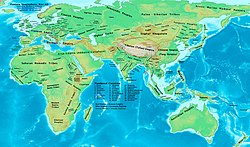Rashtrakuta literature
This era was practically the end of classical Prakrit and Sanskrit writings when a whole wealth of topics were available to be written in Kannada.
Court poets and royalty created eminent works in Kannada and Sanskrit, that spanned such literary forms as prose, poetry, rhetoric, epics and grammar.
[6][7] The author underplays the role of the Hindu god Krishna and favourably compares his patron king Chalukya Arikesari (a Rashtrakuta feudatory) to Arjuna, while casting a lofty and noble image of Karna and the Kaurava prince Duryodhana.
[4] Another great writer in Kannada was Ponna, patronised by King Krishna III and famed for his description of the life of the 16th Jain tirthankara Shantinatha entitled Santipurana.
[1][9] Adikavi Pampa, Sri Ponna and Ranna (court poet of Western Chalukya King Tailapa II) are called the "three gems" of Kannada literature.
These writings, which are not extant now, have been praised by later day poets such as Jayakirthi,[10][11] and grammarian Kesiraja, (author of Shabdamanidarpana in c.1260 C.E), who cite Asaga as an authoritative writer of his time and place him along with other masters of early Kannada poetry.
[13] Jinachandra, who is referred to by Sri Ponna as the author of Pujyapada Charita, had earned the honorific "modern Samantha Bhadra".
[15] The inscriptions of the Rashtrakutas show a remarkable change, moving away from the purely documentary Kannada prose of the previous centuries to a more expressive language suffused with literary characteristics.
His classics were Nalachampu (915), the earliest in champu style in Sanskrit, Damayanti Katha, Madalasachampu and Begumra plates.
[22] Halayudha patronised by King Krishna III wrote Kavirahasya, a list of verbs with their meanings written in verse and a work on prosody called Mritasanjivini.
[28][29] The second writing reviews the subject matter of Arthashastra from the standpoint of Jain morals in a clear and pithy manner.
[30] King Amoghavarsha I himself a noted poet wrote Prashnottara Ratnamalika, a book of high value on religion, later translated into Tibetian language.
[22] Akalanka Bhatta wrote Rajavarthika, Nyayavinishchaya, Ashtashati and the Laghiyastraya, Lakshmidhara compiled Vyavahara Kalpataru, Khandana Khanda Khadya and others.

